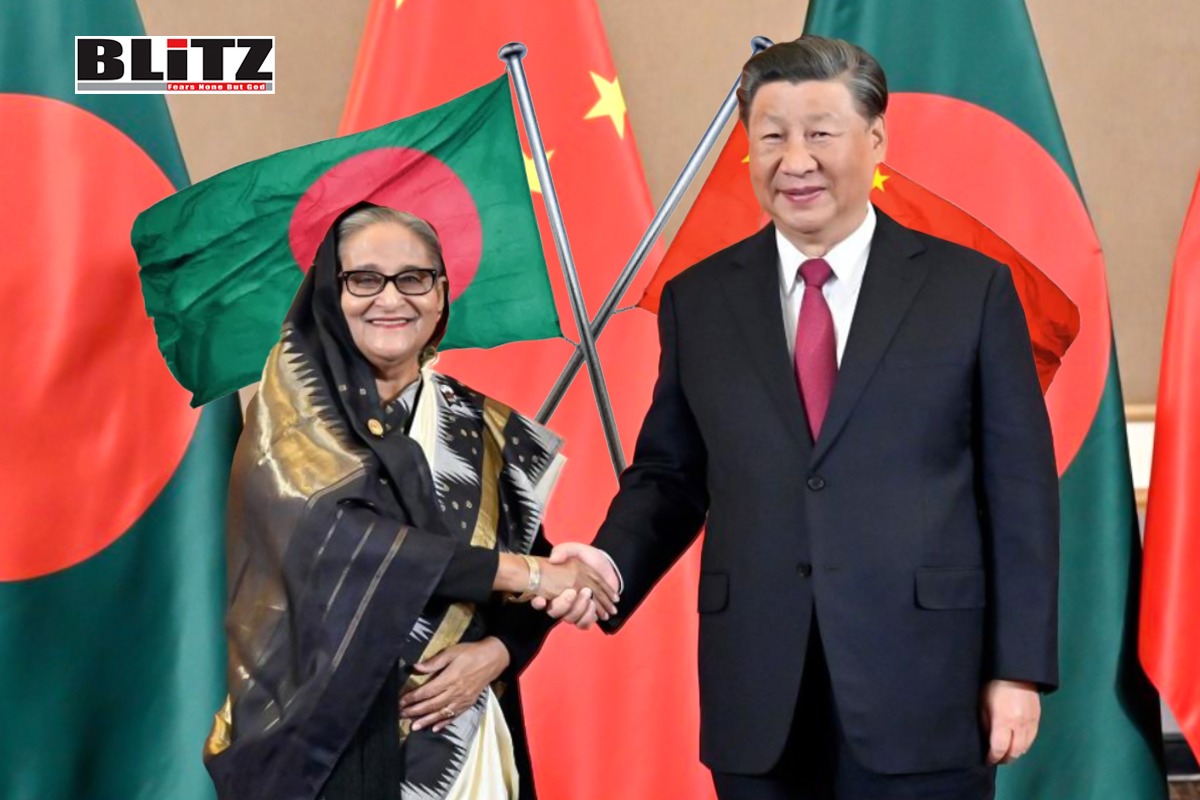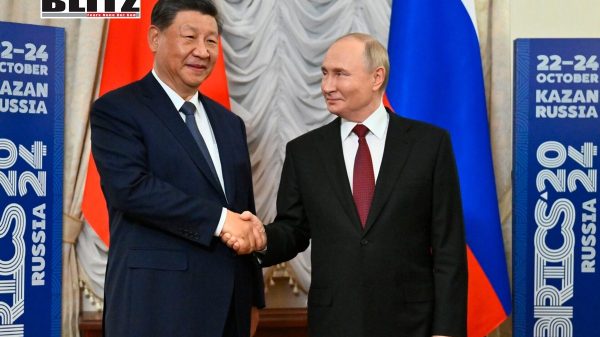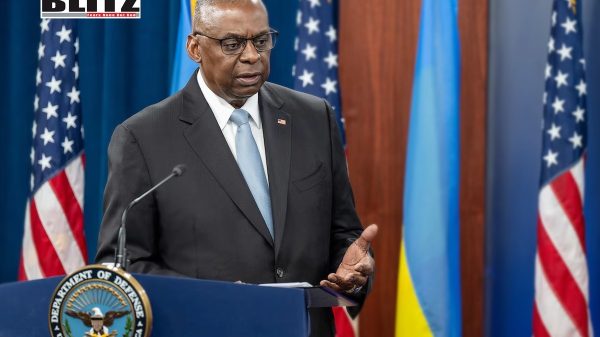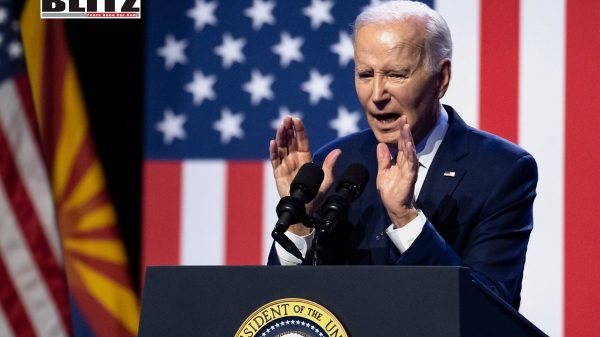Prospective future of Bangladesh-China relations
- Update Time : Wednesday, July 3, 2024

The bilateral relationship between Bangladesh and China has undergone significant transformations since the mid-20th century, evolving from initial diplomatic estrangement to a robust partnership characterized by economic cooperation and a deep strategic alignment. From the era of British colonial rule to the contemporary geopolitical landscape, the dynamics between these two nations have been influenced by a myriad of historical events, ideological shifts, and pragmatic decisions. This complex interplay has shaped a multifaceted relationship that continues to impact South Asia’s socio-economic and political fabric, and the strategic alignment between the two nations bodes well for the future of their relationship.
The roots of the China-Bangladesh relationship can be traced back to the British colonial era, which created a geographical and political chasm between India, particularly Bengal, and China. Despite this separation, prominent Bengali leaders such as Mohammad Ali of Bogra, Maulana Bhashani, and Huseyn Shaheed Suhrawardy spearheaded early initiatives to bridge the gap. In 1957, key figures from Pakistan, including Prime Minister Suhrawardy, Chief Minister of East Pakistan Ataur Rahman Khan, and Provincial Minister of Industry and Trade Sheikh Mujibur Rahman, visited China. This visit was reciprocated by Chinese Premier Zhou Enlai’s visit to Bangladesh, signaling a nascent interest in fostering bilateral ties.
Post-World War II, the geopolitical landscape saw a polarized world with the United States pursuing imperialist policies to establish global dominance. Newly independent India, reflecting its anti-British stance and socialist ideals, gravitated towards the Soviet Union, leaving the US to focus on Pakistan. China, initially inward-looking and adversarial towards the Soviet Union, found a strategic partner in the US through Pakistan, culminating in the historic ‘Ping-Pong Diplomacy’ of 1971, a term used to describe the exchange of table tennis players between the United States and China that led to a thaw in relations. This event marked a significant shift in China’s foreign policy and approach towards the US and its allies.
During the Bangladesh Liberation War in 1971, China’s geopolitical interests aligned with Pakistan, leading to its support for Pakistan and a delayed recognition of Bangladesh’s independence. Despite initially advising a negotiated solution to the conflict, China used its veto power to block Bangladesh’s entry into the United Nations. However, following the assassination of Bangabandhu Sheikh Mujibur Rahman, China’s stance softened, leading to the eventual recognition of Bangladesh and the establishment of diplomatic relations.
The father of the Nation, Bangabandhu Sheikh Mujibur Rahman, post-independence, made concerted efforts to improve relations with China. He pursued diplomatic channels, sent commercial delegations, and refrained from public criticism of China. These efforts bore fruit, with China extending food aid during the 1974 famine and inviting Bangladesh to participate in the Canton Trade Fair. The signing of the ‘Simla Agreement’ between Bangladesh, India, and Pakistan further paved the way for China’s support for Bangladesh’s UN membership and entry into the World Health Organization. The Simla Agreement, signed in 1972, was a significant diplomatic achievement that normalized relations between India and Pakistan, thereby reducing regional tensions and creating a conducive environment for other countries, including China, to engage with Bangladesh.
The relationship saw further developments as Maulana Bhashani, a follower of Mao Zedong, maintained close ties with the Chinese Communist Party. After Bangabandhu Sheikh Mujibur Rahman’s assassination in 1975, anti-independence forces in Bangladesh established formal diplomatic relations with China, continuing an anti-India stance. Subsequent governments maintained this trajectory, although relations cooled with the Awami League.
A significant shift occurred in 1993 when Sheikh Hasina, as the opposition leader, visited China, marking the ‘thawing visit.’ This visit was a turning point in Bangladesh-China relations, signaling a willingness from both sides to overcome past differences and work towards a more cooperative relationship. Her subsequent visit as Prime Minister in 1996 melted the ice, leading to a renewal of bilateral ties. By 2009, under her leadership, Bangladesh leveraged the changing international dynamics—marked by deteriorating US-China relations and the dissolution of the Soviet Union—to attract unprecedented Chinese investment and support.
The contemporary phase of Bangladesh-China relations began in the mid-1990s with Sheikh Hasina’s diplomatic efforts to thaw the historically cold relationship. Her visits to China in 1993 and 1996 were pivotal, marking a gradual improvement in bilateral ties. The geopolitical landscape had also shifted significantly when Sheikh Hasina’s government came to power again in 2009. The once robust Sino-American relationship had deteriorated. China emerged as a global economic power station interested in expanding its influence through initiatives like the Belt and Road Initiative (BRI).
During Sheikh Hasina’s tenure, Chinese investment in Bangladesh surged dramatically. This investment has been crucial for Bangladesh’s infrastructure development, aligning with its ambitions to become a middle-income country by 2021 and an intelligent, developed country by 2041. The bond between China and Bangladesh is deep. It has grown stronger over the years, as highlighted by the visits of key leaders such as President Xi Jinping in 2016 and Prime Minister Sheikh Hasina in 2019, which elevated bilateral ties to a strategic cooperative partnership.
The relationship is built on three core principles: friendship, cooperation, and potential. Both nations share ambitious development goals. China aims to become a great modern socialist country, while Bangladesh is progressing towards ‘Smart Bangladesh’ and ‘Sonar Bangla.’ This shared vision promises even greater cooperation. Looking ahead, China remains a steadfast partner, committed to shared development and security, promoting common values, and shouldering responsibilities to uphold international fairness and support developing countries.
Analysis of bilateral relationship between Dhaka and Beijing
Bilateral trade growth: Over the past decade, bilateral trade between Bangladesh and China has experienced significant growth, with trade volumes surpassing $18 billion in 2023. This substantial increase reflects the expanding economic ties and diversified trade relationships between the two nations. In the fiscal year 2022-23, Bangladesh imported goods worth $75.6 billion, with the majority, amounting to $19.35 billion, coming from China. The imports from China were worth $12.93 billion in the previous fiscal, which indicates a year-on-year rise of $6.42 billion.
The export earnings from China in the fiscal year 2022-23 were nearly $680 million, only three and a half percent of imports from the country.
Investment in infrastructure: China’s involvement in mega infrastructure projects in Bangladesh, such as the Padma Bridge, Karnaphuli Tunnel, sewage treatment plant in Dhaka, a four-tier national data center, the Padma Bridge rail link, single-point mooring in Chattogram, Dhaka-Ashulia elevated expressway, development of a power supply line under PGCB, power supply system under DPDC, an extension of the national information technology network, and the surface water supply project of Rajshahi WASA, exemplifies the successful collaboration between the two countries. Completing such projects has enhanced Bangladesh’s infrastructure and boosted economic development and connectivity within the region. During President Xi’s visit in 2016, several Memoranda of Understanding and agreements were signed between Bangladesh and China. Under the BRI, Bangladesh will receive $26 billion for BRI projects and $14 billion for joint venture projects, totaling a $40 billion package.
Industrial cooperation: Chinese investment in Bangladesh’s industrial sector is significant, driving industrial expansion and generating employment prospects. Chinese enterprises have brought expertise, technology, and financial resources to various industries in Bangladesh, fueling innovation and enhancing productivity. Bangladesh currently hosts around 700 Chinese firms, which have created more than 550,000 job opportunities for residents. The Belt and Road Initiative (BRI) stands out as a significant development partnership aligning with Vision 2041 and Smart Bangladesh on the nation’s path to modernization.
American Enterprise Institute (AEI), an esteemed think tank in Washington, reported that the total Chinese investment in Bangladesh is estimated at approximately $7.07 billion. Moreover, Chinese companies have secured construction contracts valued at $22.94 billion across different projects in the country.
Strategic dialogue: Regular high-level exchanges and strategic dialogues between officials from Bangladesh and China have bolstered diplomatic ties and facilitated critical discussions on bilateral and regional matters. These interactions have laid the groundwork for increased collaboration and mutual comprehension between the two nations. China and Bangladesh have continued to advance their Strategic Partnership of Cooperation this year. Chinese President Xi Jinping and Prime Minister Sheikh Hasina engaged in face-to-face discussions after a four-year interval, injecting fresh vigor and momentum into developing China-Bangladesh relations. The economic relationship between China and Bangladesh is robust, with Beijing having invested more than $25 billion in diverse projects in Bangladesh, marking the second-highest investment in a South Asian nation after Pakistan. China has played a significant role in developing infrastructure such as bridges, roads, railways, airports, and power plants in Bangladesh.
Defense cooperation: Bangladesh and China have embarked on defense cooperation initiatives, encompassing military exchanges, joint exercises, and procuring defense equipment. This collaboration has strengthened defense capabilities and fostered security cooperation between the two countries. The defense partnership between China and Bangladesh originated in 1975, following China’s recognition of Bangladesh. Over the years, China has provided military training and hardware, establishing itself as Bangladesh’s primary source of such materials.
Joint military exercises between China and Bangladesh have significantly impacted regional dynamics. Defense cooperation is a crucial element of the bilateral relationship between the two nations. 2002, they formalized the Defence Cooperation Agreement, making China the sole country with such a comprehensive defense pact with Bangladesh. China accounted for approximately 74% of Bangladesh’s arms imports from 2010 to 2019, while Bangladesh represented 20% of China’s total arms imports between 2015 and 2019. China supplies a wide range of military equipment to Bangladesh, including tanks, fighter jets, submarines, frigates, anti-ship missiles, and small arms. A 2014 agreement stipulates that China will provide training and equipment to the Bangladesh military.
Furthermore, China is assisting Bangladesh in constructing and establishing its inaugural submarine base, which will accommodate Chinese-manufactured submarines and feature various facilities such as wharves, barracks, ammunition depots, and repair docks.
Padma Bridge construction: With significant Chinese involvement, the ongoing construction of the Padma Bridge stands as a landmark infrastructure project that will enhance transportation networks and facilitate economic growth in Bangladesh. The completion of this bridge is set to transform connectivity and trade dynamics in the region.
Power sector development: China’s contributions to Bangladesh’s power sector development, including the construction of power plants and energy infrastructure, have helped address energy shortages and improve access to electricity for the population. These initiatives have played a vital role in supporting Bangladesh’s economic growth and industrial development. Data from September 2021 showed that China had invested USD 450 million in coal power plants in Bangladesh. According to the Bangladesh Working Group on External Debt, two such power plants with a combined capacity of 1,845 MW, backed by Chinese companies, are already in operation.
Educational partnerships: Collaborative educational programs and student exchanges between Bangladesh and China have enriched academic experiences and promoted cultural understanding among students from both countries. These initiatives have fostered cross-cultural learning and academic excellence. According to the official statement of the Bangladesh China Youth Student Association (BCYSA), around 12,000 Bangladeshi students are studying in China.
Cultural events: Various cultural events, art exhibitions, and cultural festivals organized by Bangladesh and China have promoted cultural exchange and celebrated the rich heritage of both nations. These events have strengthened cultural ties and enhanced people-to-people connections between the citizens of Bangladesh and China. Almost all famous cultural programs are celebrated by bilateral organizations like China Bangladesh Friendship Center-CBFC and other people-to-people organizations.
Strategic pathways for enhanced cooperation, Prospects and recommendations
Given the historical context and current dynamics, several strategic steps are necessary to enhance Bangladesh-China relations further:
Enhanced trade relations: Bangladesh should seek to negotiate more favorable trade agreements with China to reduce the trade deficit and promote exports of Bangladeshi products. This can include textiles, agricultural products, and pharmaceuticals. Joint economic commissions can help identify and resolve trade barriers, promoting a balanced trade relationship.
Bangladesh must diversify its export offerings to address the trade deficit and seek duty-free access to more products in the Chinese market. The country could explore joint ventures with Chinese companies and organize more trade fairs and exhibitions to promote Bangladeshi products in China. These strategies can help Bangladesh balance its trade relationship with China.
Bangladesh has requested $5 billion in soft loans from China. While China provides project loans to Bangladesh, Bangladesh has never requested soft loans, especially for such a large amount. The loan request was made to cover the country’s dwindling foreign reserve as Bangladesh faces an economic crisis. China should respond to this demand from Bangladesh.
Investment in technology and innovation: Encouraging Chinese investment in Bangladesh’s technology and innovation sectors can significantly benefit the country. Collaborations in information technology, renewable energy, and advanced manufacturing can foster technological advancements and create high-value jobs in Bangladesh.
People-to-people connectivity: Increasing people-to-people connectivity through academic exchanges, tourism, and cultural programs can strengthen bilateral ties at the grassroots level. Scholarships for Bangladeshi students, joint research projects, and cultural exchange programs can build a deeper understanding and appreciation between the two nations.
Infrastructure development: Bangladesh should prioritize infrastructure projects that align with its long-term development goals, such as transportation networks, energy infrastructure, and urban development. Collaborating with China on these projects can accelerate their completion and enhance Bangladesh’s economic landscape.
Healthcare cooperation: In light of global health challenges, Bangladesh can benefit from cooperation with China in the healthcare sector. Joint medical research, pharmaceuticals, and public health initiatives can improve healthcare outcomes and prepare both nations for future health crises.
Security and stability: While economic cooperation is paramount, ensuring regional security and stability should not be overlooked. Bangladesh should continue to engage in diplomatic dialogues with China to address regional security concerns and ensure that the economic partnership does not lead to geopolitical tensions.
Environmental and sustainable development: Collaborative environmental conservation and sustainable development efforts can be mutually beneficial. Joint renewable energy, waste management, and climate change mitigation projects can promote sustainable growth and environmental protection.
Leveraging multilateral platforms: Bangladesh should actively participate in regional and global multilateral platforms where China is a key player. Organizations such as the Shanghai Cooperation Organization (SCO) and the Asian Infrastructure Investment Bank (AIIB) offer opportunities for Bangladesh to engage with China and other member states on issues of mutual interest, including economic development, security, and environmental sustainability.
Economic diversification: While Chinese investment is crucial, Bangladesh must diversify its economic partnerships to ensure resilience against potential economic or political fluctuations. Engaging with other major economies, such as the European Union, Japan, and South Korea, can provide alternative sources of investment and trade opportunities.
Human resource development: Investing in human resource development is essential for Bangladesh to maximize the benefits of Chinese investment. This includes enhancing vocational training programs, improving education standards, and fostering a culture of innovation and entrepreneurship. A skilled workforce will attract higher-value investments and drive sustainable economic growth.
Crisis management and humanitarian cooperation: Building mechanisms for crisis management and humanitarian cooperation can strengthen the Bangladesh-China partnership. Joint efforts in disaster relief, emergency response, and public health crises will showcase the resilience and solidarity of the bilateral relationship.
Soft power and public diplomacy: Bangladesh should employ soft power and public diplomacy to enhance its image and influence within China. Promoting Bangladeshi culture, heritage, and achievements through cultural festivals, media exchanges, and tourism initiatives can build a positive perception and foster goodwill among the Chinese populace.
Research and development collaborations: Joint research and development (R&D) centers can drive innovation and technological advancements in both countries. Collaborative projects in biotechnology, artificial intelligence, and renewable energy will contribute to knowledge sharing and technological progress.
Legal and regulatory frameworks: Strengthening legal and regulatory frameworks to protect the interests of investors and ensure transparent business practices is crucial. Bangladesh should enhance its legal infrastructure to create a conducive environment for Chinese businesses and investors.
Monitoring geopolitical shifts: Bangladesh must remain vigilant and adaptive to geopolitical shifts that could impact its relationship with China. Maintaining a balanced foreign policy that aligns with national interests and regional stability will be essential in navigating potential challenges.
The evolution of Bangladesh-China relations from a period of political divergence to a strategic partnership underscores the dynamic nature of international diplomacy. This transformation has shaped historical contexts, geopolitical shifts, and pragmatic economic considerations. From initial skepticism and political divergences during the Cold War era to the robust partnership of today, the relationship has continually adapted to changing global and regional dynamics.
The Father of the Nation, Bangabandhu Sheikh Mujibur Rahman’s early diplomatic efforts laid the groundwork for a more cooperative relationship, later solidified through subsequent regimes and pivotal visits by leaders like Sheikh Hasina. The contemporary phase of this relationship has been characterized by significant Chinese investments, particularly under the Belt and Road Initiative (BRI), which have played a crucial role in Bangladesh’s infrastructure development and its ambitions to become a middle-income country.
As both nations look to the future, strategic steps focused on economic cooperation, balanced diplomatic relations, diversification of trade, and technological and educational exchanges will be essential. Environmental sustainability, cultural diplomacy, and participation in multilateral platforms will also be critical in ensuring the relationship remains mutually beneficial and resilient.
Moreover, investing in human resource development, crisis management, humanitarian cooperation, and leveraging soft power and public diplomacy will further strengthen bilateral ties. Establishing joint research and development centers, enhancing legal and regulatory frameworks, and maintaining vigilance to geopolitical shifts are crucial for sustaining and advancing the partnership.
The Bangladesh-China relationship exemplifies how historical complexities and contemporary necessities can converge to shape a strategic partnership. As Bangladesh continues its journey toward economic growth and development, leveraging China’s economic prowess while safeguarding its national interests will be vital. With careful management and strategic planning, the partnership between Bangladesh and China can serve as a model for other developing nations navigating the complexities of global diplomacy. This evolving relationship, grounded in mutual respect and shared goals, promises significant economic growth and regional stability, benefiting both nations and the broader South Asian region.















Leave a Reply